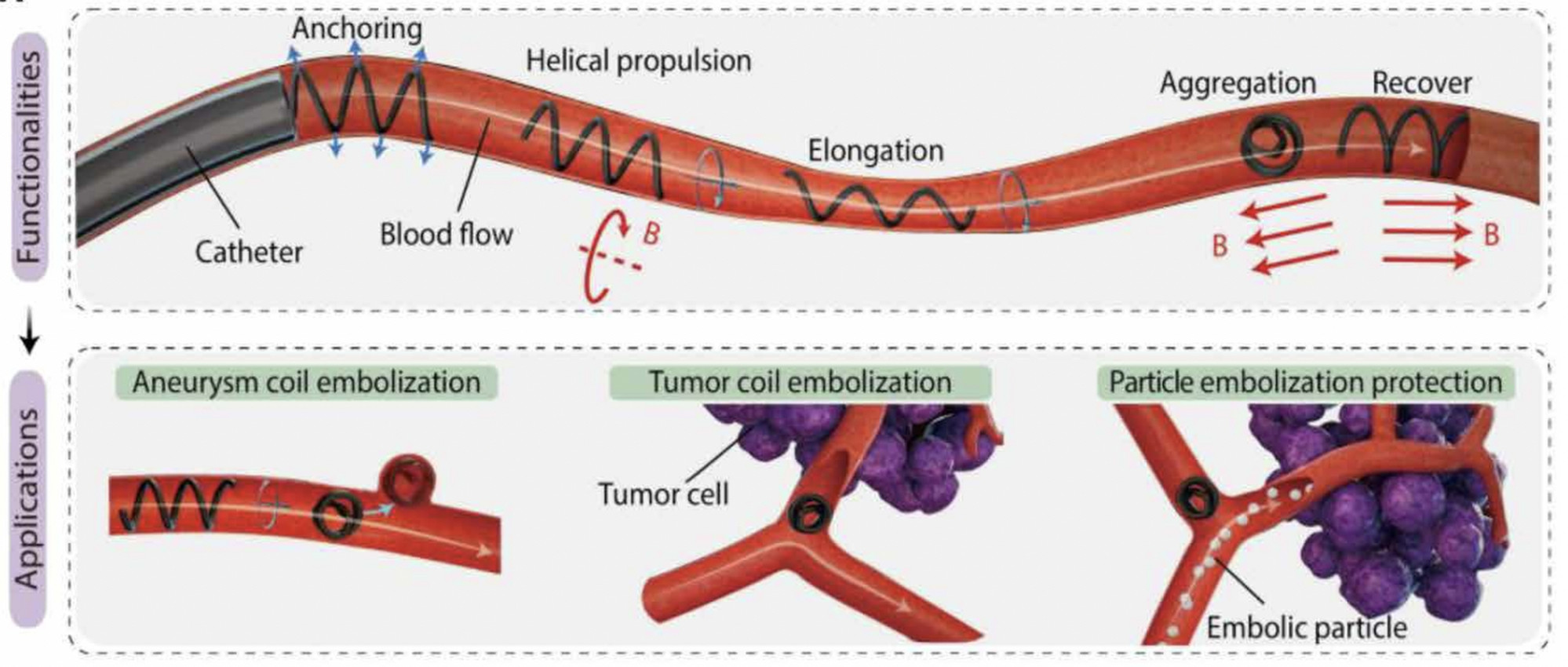
Chinese scientists create tiny robot that could help treat brain aneurysms and tumours
- Embolisation is one of the first treatments for these life-threatening conditions that kill more than 750,000 people a year
- Team says magnetic ‘microfibrebot’ can block blood supply and its coiled shape allows for more control than other methods
The soft “microfibrebot” does this by cutting off the flow of blood to the aneurysm or tumour.
Its coiled shape allows for more control and accuracy than other minimally invasive methods used to treat these conditions, and the researchers say tests done on blood vessel models and rabbits have shown promise for clinical use.
Brain aneurysms and tumours are life-threatening conditions that kill more than 750,000 people a year.
Embolisation to stop the blood flow is one of the first treatments. This minimally invasive procedure is typically done by inserting a catheter into the femoral artery and moving it through the blood vessels until it reaches the target site, where embolic agents to seal off the vessel are delivered.
AI tool for brain cancer prognosis created by team led by Hong Kong scientists
But this method “is often limited by the poor steerability of the catheter in complex neurovascular networks”, the researchers wrote in a paper published in the peer-reviewed journal Science Robotics on Wednesday.
They noted that it also exposes surgeons to radiation for long periods as the procedure is performed manually under an X-ray.
While robots have been proposed to move the catheter remotely, they said the idea “remains a challenge” due to problems like buckling.

To address these issues, the team – from Huazhong University of Science and Technology in Wuhan, the University of Science and Technology of China in Hefei, and Shanghai Jiao Tong University – designed an untethered, magnetically controlled soft robot.
Their study found it could perform robotic embolisation in blood vessel branches that conventional catheters were unable to reach.
“The microfibrebot, composed of a magnetised fibre coiled into a helix shape, can conform to different vessel sizes and performs a corkscrew propulsion when subjected to an external magnetic field,” Melisa Yashinski, associate editor of the journal, wrote in an editor’s summary of the paper.
“These proposed robots provide a controllable alternative to conventional catheter-based embolisation.”
The robot is tiny – about half a millimetre. It can change shape by elongating or aggregating and can be steered up and down using magnetic fields.
And since it will have to travel a long way to reach target blood vessels, the team proposed it be used as a supplement to catheter-based embolisation to “maximise their clinical effectiveness”.
A catheter would be used to get close to the target, then the robot would be injected into the blood vessel via the catheter and steered where it needs to go using X-ray imaging.
“If the microfibrebot goes into a wrong branch vessel, it can be readily reoriented to the right track,” the team wrote.
Micro robot made by Hong Kong academics kills 99% of medical implant bacteria
Once the robot is at the target, it can perform embolisation in two ways.
It can aggregate in a vessel branch to form a tight shape that blocks the blood supply. This could reduce bleeding from aneurysms and stop the flow of blood to brain tumours.
The researchers said it would be possible to use multiple robots for this treatment since the magnetic fields guiding others would not cause an aggregated robot to move.
Embolisation of a brain tumour can also be done by sending particles into a vessel branch to aggregate and “starve the tumour for accelerated removal”. Cutting off blood flow to a tumour causes it to stop growing and can even shrink the tumour by killing cells, according to the paper.
For this type of embolisation, the robot is used to block off a “healthy” vessel before particles are released into the target branches. Once complete, the robot can be removed from the healthy branch.
In tests on a model vessel system, the team found that dual robots in a healthy branch had a particle blocking ratio of up to 88 per cent.
The robots were also tested on the hind legs of rabbits. Three weeks after embolisation, the robots continued to block blood flow and tests on the rabbit organs found “no inflammation or pathological abnormalities”, the researchers said.
They cautioned that the robots were “still in their infancy” and that further testing was needed using different robot sizes, materials and positioning systems to guide them such as ultrasound.
But they concluded that the devices have potential. “We envisage that our magnetic soft microfibrebots will pave the way for the untethered robotic embolisation of cerebral aneurysms and brain tumours in the future,” the paper said.

